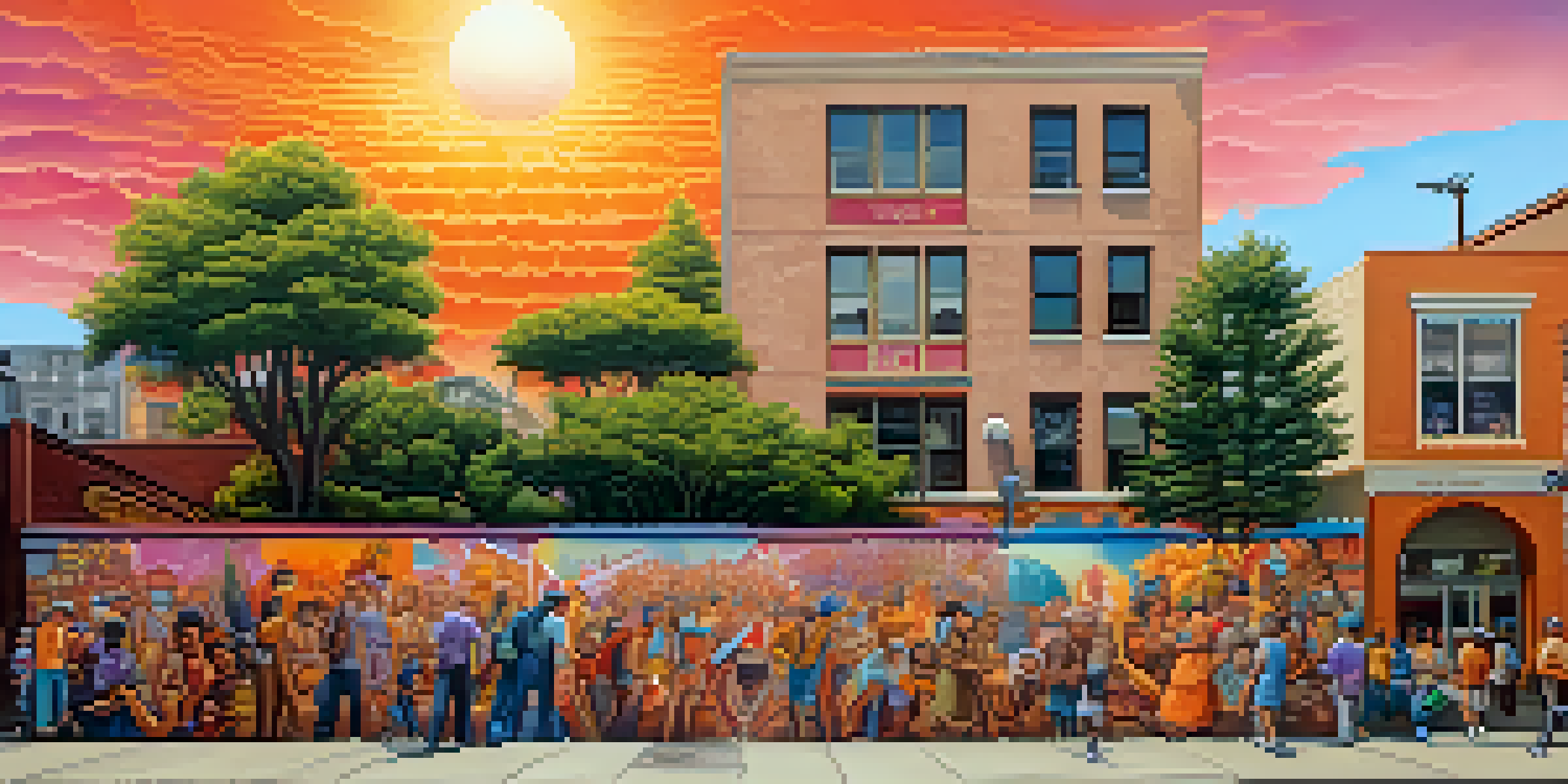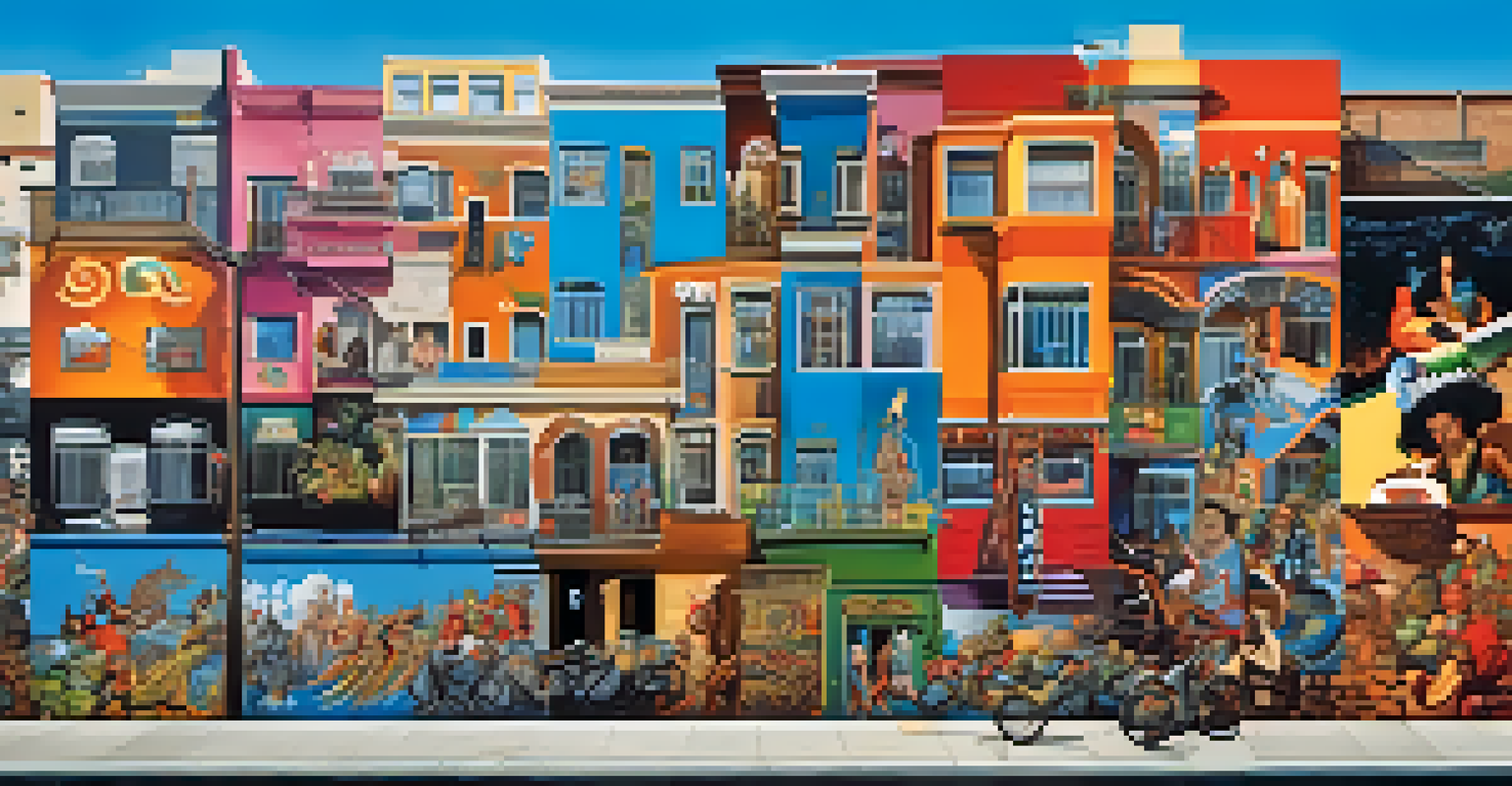Folklore and Street Art: A Modern Artistic Dialogue

Understanding Folklore: A Treasure Trove of Stories
Folklore is more than just tales passed down through generations; it's a rich tapestry of culture, beliefs, and practices. These stories often reflect the values and struggles of a community, encapsulating their identity in a way that's both relatable and timeless. Just like a favorite childhood story, folklore connects us to our roots and helps us understand who we are.
Folklore is the heart of a community. It is the spirit of the people, the voice of their past and the light of their future.
In many cultures, folklore serves as a moral compass, teaching lessons about life, love, and community. For instance, think about the classic fairy tales that warn us about greed or the importance of kindness. These narratives often find their way into art, influencing how artists express these age-old themes in contemporary forms.
As we dive deeper into the world of art, we see how folklore acts as a foundation for creativity, inspiring artists to reinterpret traditional motifs in modern contexts. This dialogue between the past and present creates a vibrant landscape where stories come alive in unexpected ways.
Street Art: The Voice of the Urban Landscape
Street art has emerged as a powerful form of expression, transforming blank walls into canvases that reflect contemporary issues and emotions. Unlike traditional art, street art is often created in public spaces, making it accessible to everyone—think of it as art for the people. This immediacy allows artists to engage with their audience directly, often sparking conversations about social, political, and cultural themes.

Many street artists use their work to challenge the status quo, addressing topics like inequality, environmental issues, and community struggles. This raw, unfiltered approach mirrors the spirit of folklore, where stories often arise from real-life experiences. Just as folklore captures the essence of a community, street art gives voice to its concerns and aspirations.
Folklore Enriches Community Identity
Folklore serves as a cultural foundation, reflecting the values and struggles of a community while connecting individuals to their roots.
Moreover, street art can serve as a modern-day folklore, with its own set of symbols and narratives that resonate with urban populations. Through vibrant murals and thought-provoking graffiti, artists create a dialogue that reflects the complexities of city life, blending tradition and innovation in a unique way.
The Intersection of Folklore and Street Art
When folklore meets street art, the result is a fascinating fusion that breathes new life into traditional stories. Artists often draw upon folklore to create pieces that resonate with both local and global audiences, using familiar tales to address contemporary issues. This intersection allows for a reinterpretation of cultural narratives, making them relevant for today's society.
Art is the most beautiful of all lies; it is a way to express the truth of our existence.
For example, a street artist might depict a local legend through a mural that captures the essence of the tale while also commenting on modern-day challenges. This not only honors the original story but also invites viewers to engage with it in a fresh context. It's a beautiful reminder that stories can evolve, adapting to the changing times while retaining their core meaning.
This blending of art forms encourages a sense of community, as shared folklore becomes part of the urban landscape. It fosters connections among people, bridging generational gaps and sparking conversations about heritage and identity.
Case Studies: Notable Artists Merging Folklore and Street Art
Several contemporary artists have successfully merged folklore with street art, each bringing their unique perspective to the canvas. One notable example is the work of Brazilian artist Kobra, who often incorporates elements of indigenous culture and folklore into his vibrant murals. His pieces not only showcase the beauty of Brazilian heritage but also raise awareness about environmental issues facing the Amazon rainforest.
Another artist, the Mexican muralist Saner, integrates elements of Mexican folklore into his street art, drawing inspiration from traditional myths and legends. His work serves as a celebration of identity, highlighting the rich tapestry of Mexican culture while addressing modern social issues. These artists exemplify how folklore can be reimagined in urban settings, breathing new life into age-old stories.
Street Art as Modern Folklore
Street art transforms urban spaces into vibrant canvases that address contemporary issues, mirroring the storytelling essence of traditional folklore.
By showcasing these narratives through street art, these artists contribute to a broader dialogue about culture, identity, and community. Their work invites viewers to reflect on their heritage while considering the contemporary world around them.
The Role of Community in Shaping Artistic Expression
Community plays a vital role in both folklore and street art, with each influencing the other in powerful ways. Folklore often reflects the collective experiences and values of a community, while street art serves as a canvas for those very stories. This symbiotic relationship fosters a sense of belonging and pride, as shared narratives are expressed through artistic mediums.
Local communities often engage with street art projects, contributing their own stories and perspectives to the artwork. This collaboration not only enriches the art itself but also strengthens community bonds, as people come together to celebrate their shared heritage. Think of it as a communal storytelling session, where everyone has a voice and a role to play in the narrative.
Moreover, this community involvement can lead to revitalization efforts in urban areas, where street art transforms neglected spaces into vibrant cultural hubs. By honoring folklore through art, communities can reclaim their narratives and assert their identity in an ever-changing urban landscape.
The Future of Folklore and Street Art: A Continuing Dialogue
As we look to the future, the dialogue between folklore and street art is likely to evolve even further. With the rise of digital media and technology, artists have new tools to explore and share their interpretations of traditional stories. This means that folklore can reach wider audiences, transcending geographic boundaries while still maintaining its cultural roots.
Additionally, as global issues continue to shape our world, we may see more artists using folklore to comment on contemporary challenges. By weaving traditional narratives into their work, they can create powerful statements that resonate with diverse audiences, fostering understanding and empathy in an increasingly connected world.
Collaboration Shapes Artistic Expression
The relationship between community involvement and artistic expression fosters a sense of belonging, allowing shared narratives to be celebrated through art.
Ultimately, the synergy of folklore and street art serves as a reminder of the power of storytelling in all its forms. Whether through a mural on a city wall or a tale shared around a campfire, these narratives continue to inspire and connect us, bridging the past with the present and paving the way for future generations.
Conclusion: Celebrating the Dialogue of Tradition and Modernity
The intersection of folklore and street art represents a dynamic dialogue between tradition and modernity. As artists draw upon their cultural heritage to inspire contemporary works, they create a unique space where stories can thrive and evolve. This blending of old and new not only enriches the artistic landscape but also fosters a deeper connection among communities.
By celebrating the stories of our past, we can engage with the present and inspire future generations to continue this artistic dialogue. Just like the tales we cherish, street art can serve as a reminder of our shared humanity, inviting us to reflect on our experiences and values.

In this vibrant fusion of folklore and street art, we find a testament to the power of creativity and storytelling. As we embrace this evolving narrative, we honor our cultural heritage while paving the way for a future filled with artistic expression and connection.